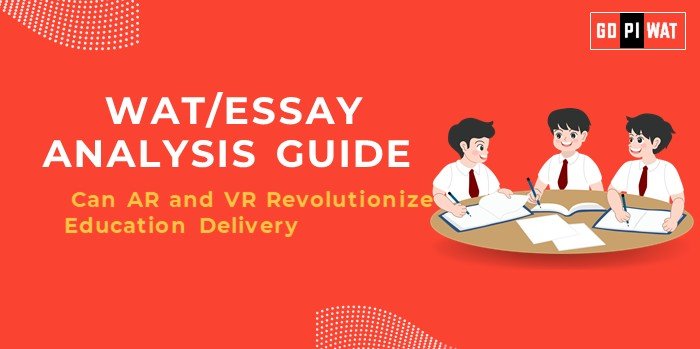📋 Can AR and VR Revolutionize Education Delivery?
🌐 WAT/Essay Analysis Guide
🔎 Understanding AR and VR’s Importance in Education
Augmented Reality (AR) and Virtual Reality (VR) are redefining the education sector by offering immersive, experiential learning experiences. They address the shortcomings of passive learning, promoting engagement, innovation, and accessibility.
Significance: The adoption of AR/VR aligns with themes of digital transformation, inclusivity, and innovation—key drivers for global education advancement.
📝 Effective Planning and Writing
- ⏳ Time Allocation:
- Planning: 5 minutes
- Writing: 20 minutes
- Review: 5 minutes
- 📌 Preparation Tips:
- Gather impactful statistics and examples (e.g., IIT Madras AR initiatives).
- Explore global comparisons such as Finland and South Korea.
- Outline challenges and propose solutions for equitable adoption.
🖊️ Introduction Techniques
Contrast Approach:
“While AR/VR can make learning captivating and engaging, the digital divide raises concerns about equitable access to such transformative tools.”
Solution-Based Approach:
“The integration of AR/VR in education offers a solution to the global challenge of passive learning by creating immersive environments that foster deeper understanding.”
📊 Structuring the Essay Body
🏆 Achievements
- 🌍 Global Success: South Korea’s education system incorporates VR to teach complex STEM concepts, achieving higher engagement rates.
- 🇮🇳 Local Example: IIT Madras uses AR tools for interactive engineering modules, improving practical understanding.
- 💡 Innovation: AR-based applications like Google Expeditions enable virtual field trips for experiential learning.
⚠️ Challenges with Comparative Analysis
- 🌐 Access Disparity: Developing nations like India face challenges in rural areas due to limited internet and device availability.
- 💻 Technological Limitations: High costs of VR hardware restrict widespread adoption.
- 👩🏫 Teacher Training: Lack of adequate training limits educators’ ability to use AR/VR tools effectively.
Comparison: South Korea’s robust tech infrastructure allows widespread VR adoption, while nations like India struggle to bridge the digital divide.
🚀 Future Outlook
- 🤖 AI Integration: Combining AI with AR/VR to provide adaptive, personalized learning experiences.
- 📉 Lower Costs: Collaboration with EdTech firms can drive innovation to reduce hardware costs.
- 🏛️ Policy Incentives: Government funding and public-private partnerships can accelerate infrastructure development.
✅ Concluding Effectively
Balanced Perspective:
“While AR/VR’s potential to revolutionize education is clear, its ultimate success depends on overcoming cost and accessibility challenges.”
Global Comparison:
“Drawing inspiration from countries like Finland and South Korea, scalable and inclusive AR/VR adoption can transform global education systems.”
🔍 Analyzing Successes and Shortcomings
- 🏅 Key Achievements: Enhanced engagement, innovative teaching methodologies, and experiential learning opportunities.
- ⚠️ Ongoing Challenges: Cost barriers, technological gaps, and unequal access.
- 🌍 Global Context: Finland’s AR-driven classrooms and South Korea’s VR-based STEM programs set benchmarks for success.
📢 Recommendations for Sustainable Progress
- 🛠️ Promote Open-Source Tools: Encourage the development of affordable AR/VR solutions.
- 👩🏫 Train Educators: Government-sponsored training programs can prepare teachers for tech integration.
- 🤝 Collaborate with EdTech: Partnerships with companies like BYJU’s and Google can ensure scalability and innovation.
📝 Sample Short Essays
⚖️ Balanced Perspective:
“AR/VR’s immersive capabilities redefine education delivery, offering deeper engagement and understanding. However, addressing cost barriers and access inequities remains crucial to ensure its inclusive success.”
💡 Solution-Oriented:
“Innovative funding strategies and public-private collaborations can make AR/VR accessible for all. Combining these tools with teacher training programs will revolutionize education delivery globally.”
🌍 Global Comparison:
“Inspired by Finland’s AR-driven classrooms and South Korea’s VR-based STEM initiatives, global education systems must prioritize infrastructure and inclusivity to maximize AR/VR’s transformative potential.”


